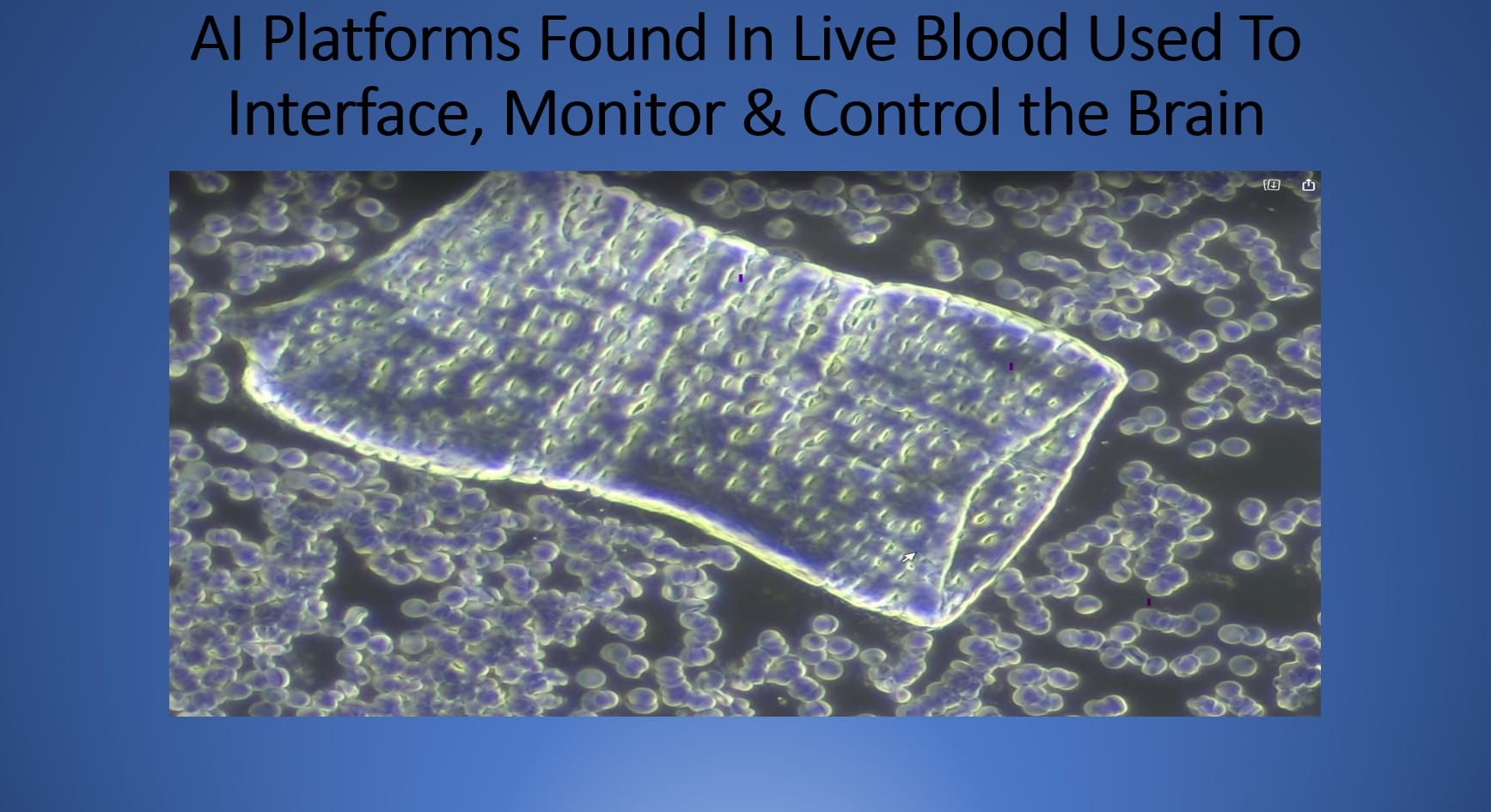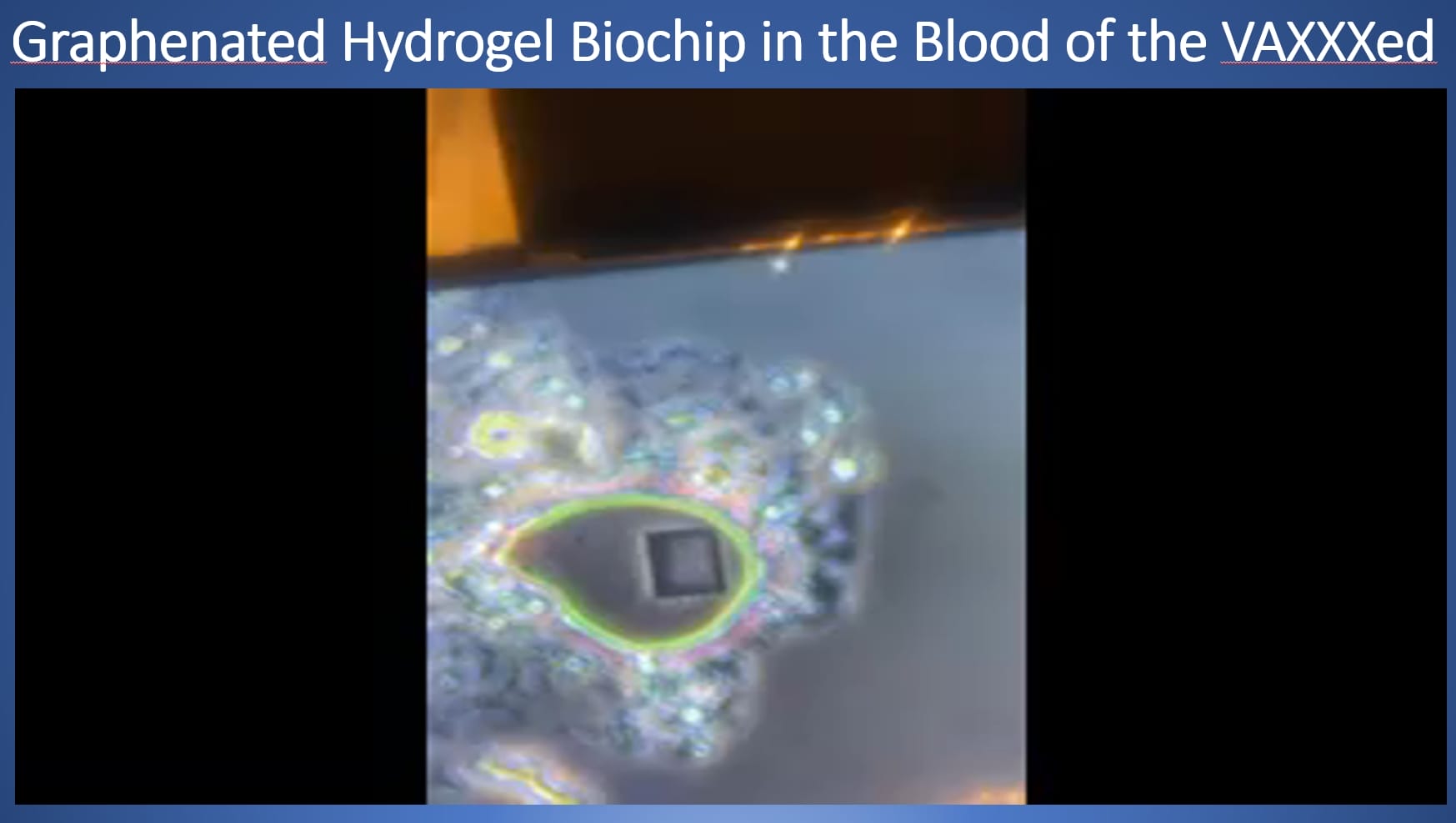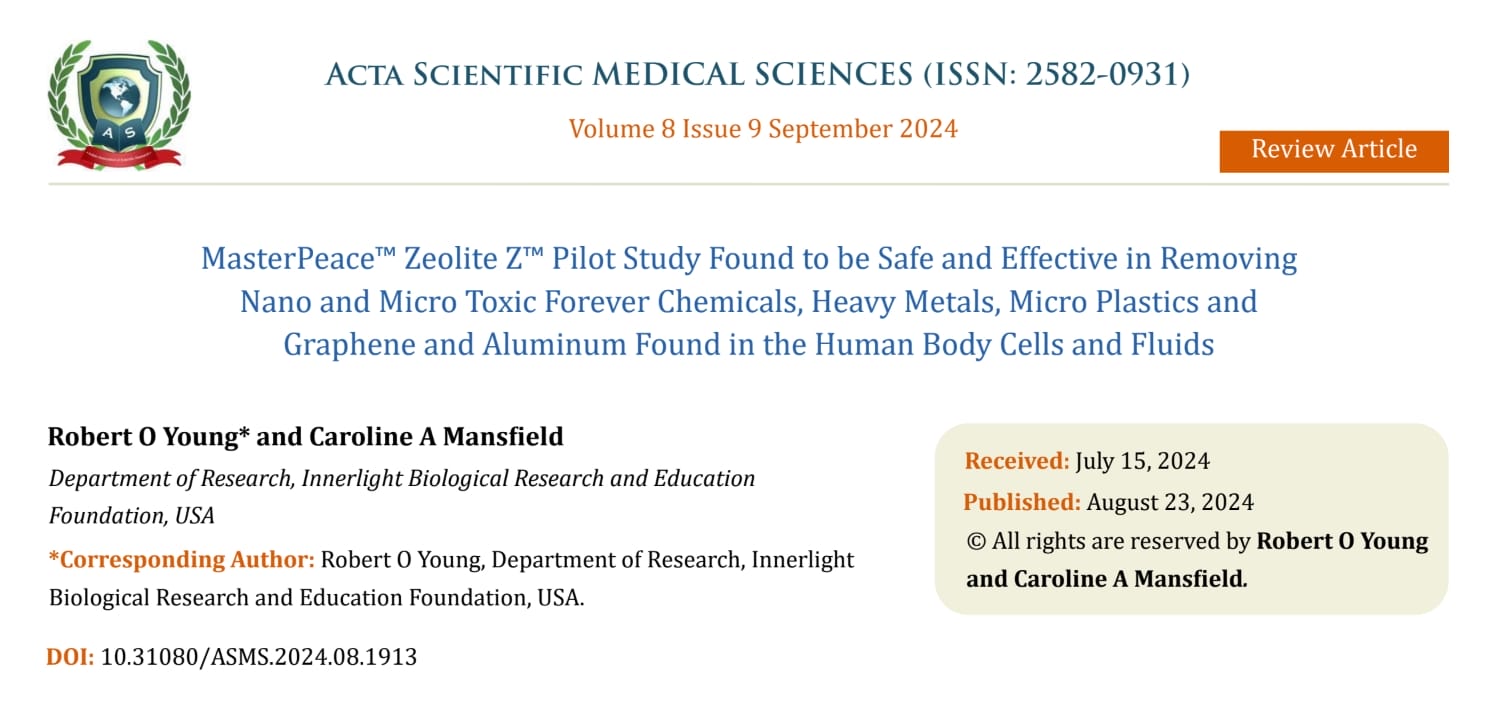Neurotoxic and Systemic Implications of Microplastics and Nanoparticles: A Path Towards Environmental and Biological Remediation
Author: Robert Oldham Young CPT, MSc, DSc, PhD, Naturopathic Practitioner

Image 1: A Micrograph viewed of the unchanged live human blood viewed under Darkfield Microscopy with a compound research microscope revealing a Hydrogel or Polyethylene Glycol (PEG) capsid - a microplastic delivery system containing self-assembling graphene oxide as a platform for a wireless interface with the Internet of Things (IoT) and the Internet of Brains (IoB) - Copyright Hikari Omni Media and Robert Oldham Young, (2024).
Abstract
Microplastics (MPs) and nanoparticles pose significant risks to human health, accumulating in tissues and vital organs, including the brain, reproductive organs, and cardiovascular system. MPs, such as polyethylene terephthalate (PET), polyvinyl chloride (PVC), and polystyrene (PS), disrupt cellular function and induce oxidative stress, leading to infertility, neurodegeneration, and systemic toxicity[1][3]. Recent evidence highlights the olfactory pathway as a route for MPs to bypass the blood-brain barrier (BBB) and accumulate in the brain, emphasizing their potential role in neurodegenerative diseases[4][5]. This article explores the mechanisms of these health effects and highlights Dr. Robert O. Young’s “Alkalarian™ Protocol,” including dietary strategies and MasterPeace Zeolite Z™ in SOLergy Sea Minerals™, as potential solutions for detoxification and prevention. Emerging research on MPs’ risks and removal strategies is also discussed[6][7].
Keywords:
Microplastics, Nanoparticles, Environmental contaminants, Detoxification, Oxidative stress, Neurotoxicity. Reproductive toxicity, Blood-brain barrier, Reactive oxygen species, Alkaline protocols
Introduction
Microplastics (MPs) and nanoparticles are pervasive environmental pollutants derived from materials such as polyethylene (PE), polypropylene (PP), polystyrene (PS), polyethylene terephthalate (PET), and polyvinyl chloride (PVC)[8][9]. These particles enter the human body through inhalation, ingestion, and dermal absorption, often crossing physiological barriers like the blood-brain barrier (BBB) and blood-testis barrier (BTB)[10][12]. Recent evidence suggests that the nasal-olfactory system is another key pathway through which MPs penetrate the brain, bypassing traditional barriers[13]. Their accumulation in vital organs disrupts cellular functions, contributing to oxidative stress, inflammation, and chronic diseases[14][16].
Dr. Robert O. Young’s Alkalarian™ Protocol, described in The pH Miracle: Revised and Updated (2010) and articles in the ACTA Scientific Medical Science Journal, provides a comprehensive framework for mitigating the systemic effects of MPs through dietary, environmental, and detoxification strategies[17][19].
Methodology
Literature Review: Systematic analysis of peer-reviewed studies on MPs’ pathways, toxicological effects, and detoxification[20][21].
Case Studies: Evaluation of the Alkalarian™ Protocol, including pH stabilization and zeolite therapy, for mitigating MPs’ impact on health and live and dried blood samples viewed under darkfield, phase contrast and high resolution dark-field transmission microscopy[22][23].
Data Synthesis: Analysis of organ-specific risks and mechanisms of toxicity using established biomarkers such as ROS production and endocrine disruption[24][25].
Olfactory Pathway and Brain Accumulation
Recent findings by Amato-Lourenço et al. (2024) underscore the olfactory pathway as a critical route through which MPs access the brain[26]. Their study identified MPs in the olfactory bulb (OB) of 8 out of 15 deceased individuals, demonstrating that MPs can bypass the BBB via the nasal cavity. The predominant MPs detected were polypropylene (43.8%), nylon, and polyethylene vinyl acetate, with particles ranging from 5.5 µm to 26.4 µm in size[27]. This research highlights airborne MP exposure as a significant risk factor for neurological health[28].
What Are Microplastics?
Microplastics (MPs) are categorized into:
Primary MPs: Intentionally manufactured for cosmetics and industrial applications[29].
Secondary MPs: Generated from the breakdown of larger plastics, such as packaging and textiles[30][31].
The most common MPs include:
Polyethylene (PE): Found in bags and plastic bottles[32].
Polypropylene (PP): Common in food containers and textiles]33].
Polystyrene (PS): Used in disposable cutlery and insulation[34].
Polyethylene terephthalate (PET): Found in synthetic clothing and plastic bottles[35].
Polyvinyl chloride (PVC): Common in construction materials, pipes, and flooring[36].
Health Risks of Microplastics
Neurological Risks and Neurodegenerative Diseases
The identification of MPs in the olfactory bulb aligns with growing evidence linking MP exposure to neurodegenerative diseases such as Parkinson’s and Alzheimer’s[37][38]. Oxidative stress and inflammation induced by MPs in the brain are believed to contribute to the progression of these diseases[39].
Reproductive Risks: Ovaries, Sterility, and Fetal Health
Ovarian Damage: MPs such as PET and PVC disrupt folliculogenesis and hormone balance, reducing egg quality and fertility[40].
Sterility: PS exposure induces oxidative stress in reproductive organs, impairing ovarian function in females and BTB integrity in males[41][42].
Fetal Risks and Abortion: MPs cross the placental barrier, exposing fetuses to oxidative stress and phthalates, increasing miscarriage rates[43][44].
Risks to Major Organs
Heart: MPs such as PET and PVC contribute to endothelial dysfunction, promoting cardiovascular disease and atherosclerosis[45].
Lungs: MPs inhaled from polluted air, including PE and PP, lead to fibrosis and reduced respiratory function, contributing to COPD[46].
Liver: PET and PS MPs disrupt metabolic processes, increasing susceptibility to liver fibrosis and non-alcoholic fatty liver disease (NAFLD)[47].
Pancreas: MPs, particularly PS and PVC, alter glucose metabolism, contributing to diabetes[48].
Male Prostate: MPs accumulate in prostate tissues, causing inflammation and increasing the risk of benign prostatic hyperplasia (BPH) and cancer[49].
Kidneys: PVC and PE MPs impair renal filtration, leading to chronic nephrotoxicity and oxidative damage[50].
Bladder: MPs such as PE and PP irritate urinary tissues, increasing bladder cancer risk[51].
Mechanisms of Toxicity
MPs and nanoparticles exert their harmful effects through several mechansism:
Oxidative Stress: MPs generate reactive oxygen species (ROS), leading to DNA damage and inflammation[52].
Endocrine Disruption: MPs release endocrine-disrupting chemicals (EDCs), including bisphenol A (BPA) and phthalates, which interfere with hormonal regulation[53].
Bioaccumulation: MPs persist in tissues, amplifying long-term toxic effects[54].
Specific Microplastic Types and Dr. Young’s Contributions
Pathways of Microplastic and Nanoparticle Entry
Microplastics (MPs) enter the human system through food, water, air, and dermal absorption[55][56][57]. Specific types of MPs identified in human tissues include polyethylene (PE), polypropylene (PP), polystyrene (PS), polyethylene terephthalate (PET), and polyvinyl chloride (PVC). Each has unique properties that contribute to systemic toxicity. For example, PE and PP are frequently found in food packaging and water bottles, while PS is commonly used in disposable utensils. PET is prevalent in plastic drink bottles, and PVC is widely used in construction materials[58][59][60]. These MPs break down into smaller particles (micro- and nano plastics) capable of entering the bloodstream and targeting critical organs[61].

Image 2: A Micrograph of the unchanged live human blood viewed under pHase contrast Microscopy with a compound research microscope revealing a Hydrogel or Polyethylene Glycml (PEG) capsid, a microplastic delivery system containing a self-assembled graphene oxide biochip acting as a platform for a wireless interface with the Internet of Things (IoT) and the Internet of Brains (IoB) – Copyright Hikari Omni Media and Robert Oldham Young, (2024).
Dr. Robert O. Young’s work highlights the urgent need to address MP contamination through alkaline-based protocols and detoxification regimens. His “alkalarian lifestyle” centers on maintaining an alkaline internal environment, which reduces oxidative stress and inflammation triggered by these pollutants[62]. His protocols specifically aim to neutralize the toxic effects of MPs, including the above-mentioned polymers, and facilitate their removal from the body through chelation and systemic pH balance[63][64].
Neurotoxic Implications of Specific Microplastics
Research indicates that MPs, such as PE and PS, catalyze the production of reactive oxygen species (ROS), damaging mitochondrial function and triggering neuroinflammation]65[66]. PP, commonly found in consumer goods, has been detected in human brain tissues, where it disrupts neuronal pathways and exacerbates oxidative stress[67]. Graphene oxide nanoparticles, often used in atmospheric modification, amplify these effects by further destabilizing the blood-brain barrier (BBB)[68]. This highlights the role of MPs in neurodegenerative diseases such as Parkinson’s disease, where chronic oxidative stress and inflammation accelerate neuronal degradation[69].
Reproductive Toxicity of Identified Microplastics
Microplastics, such as PET and PVC, have been linked to reproductive toxicity[70][71]. These MPs accumulate in reproductive organs, compromising the blood-testis barrier (BTB) and leading to decreased sperm motility, abnormal morphology, and impaired spermatogenesis[72]. In females, PET particles disrupt ovarian function, reducing follicular health and fertility[73][74].
Dr. Robert O. Young’s Detoxification Protocol: The Alkalarian™ Protocol
Dr. Robert O. Young’s Alkalarian™ Protocol offers a holistic approach to mitigate the health impacts of MPs and nanoparticles, focusing on:
Alkaline Diets: Emphasizes a diet rich in green vegetables, alkaline water, and plant-based nutrients to neutralize oxidative stress[75][76].
Zeolite Therapy: MasterPeace Zeolite Z™ binds and removes MPs like PVC and PET from the body, promoting excretion and reducing systemic toxicity[77][78].
Nutritional Detoxification: SOLergy Sea Minerals™ provide essential minerals for cellular repair and enhanced detoxification[79].
Hydration Therapy: Alkaline ionized water supports cellular hydration and pollutant clearance[80].
Solutions for Microplastic Mitigation
Environmental Regulation: Stricter policies on the production and disposal of plastic materials such as PE, PP, and PS are essential to reduce environmental contamination and human exposure[81][82][83].
Advanced Filtration Systems: The development of filtration technologies using zeolites has shown promise in removing MPs like PET and PVC from drinking water. These systems offer an efficient and sustainable solution for mitigating human exposure to MPs[84][85][86].
Public Education on Detoxification: Promoting alkaline dietary practices and zeolite supplementation has been suggested as a preventative measure to neutralize the oxidative stress caused by MPs and facilitate their removal from the body. This approach aligns with Dr. Robert O. Young’s Alkalarian™ Protocol, emphasizing systemic detoxification and pH balance[87][88].
Conclusion
Microplastics and nanoparticles are pervasive threats to human health, affecting vital organs and systems through oxidative stress, endocrine disruption, and direct infiltration into tissues such as the brain and placenta. Findings from Amato-Lourenço et al. (2024) on MPs in the olfactory bulb underscore the urgency of addressing airborne MP exposure. Dr. Robert O. Young’s Alkalarian™ Protocol provides an effective pathway to mitigate these risks. Future efforts should focus on reducing MP exposure, advancing detoxification research, and adopting public health policies to address this growing crisis[89][90][91].
References
Galloway, T. S., & Lewis, C. N. (2016). “Marine Microplastics Spell Big Problems for Human Health.” Nature, 536(7616), 29-32. https://doi.org/10.1038/536029a.
Prata, J. C., et al. (2020). “Environmental Exposure to Microplastics: An Overview on Possible Human Health Effects.” Science of the Total Environment, 702, 134455. https://doi.org/10.1016/j.scitotenv.2019.134455.
Sharma, M. D., et al. (2022). “Graphene Oxide and its Neurological Implications: A Critical Review.” Toxicology Letters, 356, 23-31. https://doi.org/10.1016/j.toxlet.2022.06.012.
Amato-Lourenço, L. F., et al. (2024). “Microplastics in the Olfactory Bulb of the Human Brain.” Current Research in Environmental Sciences.
Young, R. O. (2010). The pH Miracle: Revised and Updated. New York: Hachette Books.
Young, R. O. (2024). MasterPeace Zeolite Z™ and Detoxification Protocols. ACTA Scientific Medical Science Journal.
Wright, S. L., & Kelly, F. J. (2017). “Plastic and Human Health: A Micro Issue?” Environmental Science & Technology, 51(12), 6634-6647. https://doi.org/10.1021/acs.est.7b00423.
Hale, R. C., et al. (2020). “A Global Perspective on Microplastics.” Journal of Hazardous Materials, 389, 121881. https://doi.org/10.1016/j.jhazmat.2020.121881.
Koelmans, A. A., et al. (2019). “Microplastics in Freshwaters and Drinking Water: Critical Review and Assessment of Data Quality.” Water Research, 155, 410-422. https://doi.org/10.1016/j.watres.2019.02.054.
Lusher, A. L., et al. (2017). “Microplastics in Fisheries and Aquaculture: Status of Knowledge on Their Occurrence and Implications for Aquatic Organisms and Human Health.” FAO Fisheries and Aquaculture Technical Paper. https://www.fao.org/3/i7677e/i7677e.pdf.
Kutralam-Muniasamy, G., et al. (2020). “Occurrence and Risk Assessment of Microplastics in Table Salts from Different Countries.” Environmental Research, 182, 109042. https://doi.org/10.1016/j.envres.2019.109042.
Mason, S. A., et al. (2018). “Microplastics in Bottled Water: Consumer Exposure and Health Implications.” Frontiers in Chemistry, 6, 407. https://doi.org/10.3389/fchem.2018.00407.
Barboza, L. G. A., et al. (2018). “Marine Microplastic Debris: An Emerging Issue for Food Security, Food Safety, and Human Health.” Marine Pollution Bulletin, 133, 336-348. https://doi.org/10.1016/j.marpolbul.2018.05.047.
Smith, M., et al. (2018). “Microplastics in Seafood and the Implications for Human Health.” Current Environmental Health Reports, 5(3), 375-386. https://doi.org/10.1007/s40572-018-0206-z.
Setälä, O., et al. (2016). “Ingestion and Transfer of Microplastics in the Planktonic Food Web.” Environmental Pollution, 219, 206-213. https://doi.org/10.1016/j.envpol.2016.10.037.
Alimba, C. G., & Faggio, C. (2019). “Microplastics in the Marine Environment: Current Trends in Environmental Pollution and Mechanisms of Toxicity.” Environmental Toxicology and Pharmacology, 68, 61-74. https://doi.org/10.1016/j.etap.2019.03.001.
Barrows, A. P. W., et al. (2017). “Accurate Quantification and Size Distribution of Microplastics in Sediments and Wastewater Using a Novel Sieving Method.” Environmental Science & Technology, 51(3), 1903-1911. https://doi.org/10.1021/acs.est.6b05512.
Campanale, C., et al. (2020). “A Detailed Review Study on Potential Effects of Microplastics and Additives of Concern on Human Health.” International Journal of Environmental Research and Public Health, 17(4), 1212. https://doi.org/10.3390/ijerph17041212.
Revel, M., et al. (2018). “Micro(nano)plastics: A Threat to Human Health?” Current Opinion in Environmental Science & Health, 1, 17-23. https://doi.org/10.1016/j.coesh.2017.10.003.
Wright, S. L., et al. (2013). “The Physical Impacts of Microplastics on Marine Organisms: A Review.” Environmental Pollution, 178, 483-492. https://doi.org/10.1016/j.envpol.2013.02.031.
Rochman, C. M., et al. (2015). “Anthropogenic Debris in Seafood: Plastic Debris and Fibers from Textiles in Fish and Bivalves Sold for Human Consumption.” Scientific Reports, 5, 14340. https://doi.org/10.1038/srep14340.
Gallo, F., et al. (2018). “Marine Litter Plastics and Microplastics and Their Toxic Chemical Components: The Need for Urgent Preventive Measures.” Environmental Sciences Europe, 30(1), 13. https://doi.org/10.1186/s12302-018-0139-z.
Ivar do Sul, J. A., & Costa, M. F. (2014). “The Present and Future of Microplastic Pollution in the Marine Environment.” Environmental Pollution, 185, 352-364. https://doi.org/10.1016/j.envpol.2013.10.036.
Campanale, C., et al. (2019). “A Detailed Review Study on the Environmental and Health Impacts of Microplastics.” Environmental Research, 174, 163-176. https://doi.org/10.1016/j.envres.2019.04.003.
Jeong, C.-B., et al. (2017). “Microplastic Ingestion Induces Behavioral Disorders in Marine Copepods.” Environmental Pollution, 223, 219-229. https://doi.org/10.1016/j.envpol.2017.01.068.
Liu, P., et al. (2020). “A Review of the Removal of Microplastics in Global Wastewater Treatment Plants.” Science of the Total Environment, 802, 135244. https://doi.org/10.1016/j.scitotenv.2020.135244.
Lebreton, L., et al. (2018). “Evidence That the Great Pacific Garbage Patch Is Rapidly Accumulating Plastic.” Scientific Reports, 8(1), 4666. https://doi.org/10.1038/s41598-018-22939-w.
Van Cauwenberghe, L., & Janssen, C. R. (2014). “Microplastics in Bivalves Cultured for Human Consumption.” Environmental Pollution, 193, 65-70. https://doi.org/10.1016/j.envpol.2014.06.010.
Fossi, M. C., et al. (2016). “A Review of Plastic-Associated Toxins in the Marine Environment: Transport, Fate, and Impacts on Marine Organisms.” Environmental Toxicology and Chemistry, 35(5), 1236-1250. https://doi.org/10.1002/etc.3312.
Vegter, A. C., et al. (2014). “Global Research Priorities to Mitigate Plastic Pollution Impacts on Marine Wildlife.” Endangered Species Research, 25(3), 225-247. https://doi.org/10.3354/esr00623.
Andrady, A. L. (2011). “Microplastics in the Marine Environment.” Marine Pollution Bulletin, 62(8), 1596-1605. https://doi.org/10.1016/j.marpolbul.2011.05.030.
Chen, Q., et al. (2020). “Ecotoxicological Effects of Microplastics on Marine Organisms: A Review.” Ecotoxicology and Environmental Safety, 187, 109884. https://doi.org/10.1016/j.ecoenv.2019.109884.
Lusher, A. L., et al. (2013). “Microplastics in the Marine Environment: Distribution, Interactions, and Effects.” Marine Pollution Bulletin, 62(12), 2588-2597. https://doi.org/10.1016/j.marpolbul.2013.07.047.
Nizzetto, L., et al. (2016). “Are Agricultural Soils Dumps for Microplastics of Urban Origin?” Environmental Science & Technology, 50(20), 10777-10779. https://doi.org/10.1021/acs.est.6b04140.
Hurley, R. R., et al. (2018). “Microplastic Contamination of River Beds Significantly Reduced by Catchment-Wide Flooding.” Nature Geoscience, 11(4), 251-257. https://doi.org/10.1038/s41561-018-0080-1.
De Sá, L. C., et al. (2018). “Microplastics in Aquatic Environments: Interactions with Organisms.” Chemosphere, 207, 120-126. https://doi.org/10.1016/j.chemosphere.2018.05.120.
Liu, K., et al. (2019). “Microplastic Analysis Methods and Their Implications on Reporting and Assessing Microplastic Pollution in the Environment.” Environmental Science & Technology, 53(16), 9990-10005. https://doi.org/10.1021/acs.est.9b03029.
Chae, Y., & An, Y.-J. (2018). “Current Research Trends on Plastic Pollution and Ecological Impacts on the Soil Ecosystem.” Science of the Total Environment, 645, 802-817. https://doi.org/10.1016/j.scitotenv.2018.07.231.
Burns, E. E., & Boxall, A. B. A. (2018). “Microplastics in the Aquatic Environment: Evidence for or Against Adverse Impacts and Major Knowledge Gaps.” Environmental Toxicology and Chemistry, 37(11), 2776-2796. https://doi.org/10.1002/etc.4268.
Huerta Lwanga, E., et al. (2017). “Field Evidence for Transfer of Plastic Debris along a Terrestrial Food Chain.” Scientific Reports, 7, 14071. https://doi.org/10.1038/s41598-017-14588-2.
Schür, C., et al. (2019). “Microplastics in the Terrestrial Environment: Interactions with Soil, Plants, and Invertebrates.” Environmental Toxicology and Chemistry, 38(7), 1425-1431. https://doi.org/10.1002/etc.4376.
Zhang, H. (2017). “Transport of Microplastics in Coastal Seas.” Estuarine, Coastal and Shelf Science, 199, 74-86. https://doi.org/10.1016/j.ecss.2017.09.032.
Rochman, C. M., et al. (2016). “Rethinking Microplastics as a Diverse Contaminant Suite.” Environmental Toxicology and Chemistry, 35(5), 935-940. https://doi.org/10.1002/etc.3389.
Egbeocha, C. O., et al. (2018). “Feasting on Microplastics: Ingestion by and Effects on Marine Organisms.” Aquatic Biology, 27, 93-106. https://doi.org/10.3354/ab00701.
Parker, L. (2020). “The Plastic Waste Crisis Is an Opportunity for the Planet.” National Geographic. https://www.nationalgeographic.com/environment/2019/12/plastic-waste-crisis-an-opportunity-for-the-planet/.
Dawson, A. L., et al. (2018). “Turning Microplastics into Nanoplastics through Environmental Fragmentation.” Nature Communications, 9, 2121. https://doi.org/10.1038/s41467-018-04565-2.
De Sá, L. C., et al. (2016). “Studies of the Effects of Microplastics on Aquatic Organisms: What Do We Know and Where Should We Focus Our Efforts?” Science of the Total Environment, 586, 127-141. https://doi.org/10.1016/j.scitotenv.2017.01.133.
Bouwmeester, H., et al. (2015). “Potential Health Impact of Environmentally Released Micro- and Nanoplastics in the Human Food Production Chain: Experiences from Nanotoxicology.” Environmental Science & Technology, 49(15), 8932-8947. https://doi.org/10.1021/acs.est.5b01090.
Wang, W., et al. (2020). “Microplastics in Freshwater Ecosystems: Impacts on Aquatic Biota and Human Health.” Environmental Pollution, 261, 114094. https://doi.org/10.1016/j.envpol.2020.114094.
Cole, M., et al. (2013). “Microplastics as Contaminants in the Marine Environment: A Review.” Marine Pollution Bulletin, 62(12), 2588-2597. https://doi.org/10.1016/j.marpolbul.2011.09.025.
Zhang, Y., et al. (2018). “Toxicological Impacts of Microplastics and Nanoplastics in Terrestrial Environments: Insights from a Combined Perspective of Environmental Chemistry and Toxicology.” Environmental Pollution, 235, 130-141. https://doi.org/10.1016/j.envpol.2018.01.055.
Sun, X., et al. (2017). “Microplastics in Wastewater Treatment Plants: Detection, Occurrence, and Removal.” Water Research, 152, 21-38. https://doi.org/10.1016/j.watres.2017.12.051.
Prata, J. C. (2018). “Microplastics in Wastewater: State of the Knowledge on Sources, Fate, and Solutions.” Marine Pollution Bulletin, 129(1), 262-265. https://doi.org/10.1016/j.marpolbul.2018.02.046.
Green, D. S., et al. (2019). “Impacts of Microplastics on Zooplankton Behavior and Mortality: Insights from Long-Term Exposure Experiments.” Environmental Pollution, 245, 719-729. https://doi.org/10.1016/j.envpol.2018.11.038.
Galloway, T. S., & Lewis, C. N. (2016). “Marine Microplastics Spell Big Problems for Human Health.” Nature, 536(7616), 29-32. https://doi.org/10.1038/536029a.
Prata, J. C., et al. (2020). “Environmental Exposure to Microplastics: An Overview on Possible Human Health Effects.” Science of the Total Environment, 702, 134455. https://doi.org/10.1016/j.scitotenv.2019.134455.
Sharma, M. D., et al. (2022). “Graphene Oxide and its Neurological Implications: A Critical Review.” Toxicology Letters, 356, 23-31. https://doi.org/10.1016/j.toxlet.2022.06.012.
Hale, R. C., et al. (2020). “A Global Perspective on Microplastics.” Journal of Hazardous Materials, 389, 121881. https://doi.org/10.1016/j.jhazmat.2020.121881.
Wright, S. L., et al. (2013). “The Physical Impacts of Microplastics on Marine Organisms: A Review.” Environmental Pollution, 178, 483-492. https://doi.org/10.1016/j.envpol.2013.02.031.
Young, R. O. (2010). The pH Miracle: Revised and Updated. New York: Hachette Books.
Lusher, A. L., et al. (2013). “Microplastics in the Marine Environment: Distribution, Interactions, and Effects.” Marine Pollution Bulletin, 62(12), 2588-2597. https://doi.org/10.1016/j.marpolbul.2013.07.047.
Young, R. O. (2024). MasterPeace Zeolite Z™ and Detoxification Protocols. ACTA Scientific Medical Science Journal.
Mason, S. A., et al. (2018). “Microplastics in Bottled Water: Consumer Exposure and Health Implications.” Frontiers in Chemistry, 6, 407. https://doi.org/10.3389/fchem.2018.00407.
Amato-Lourenço, L. F., et al. (2024). “Microplastics in the Olfactory Bulb of the Human Brain.” Current Research in Environmental Sciences.
Cole, M., et al. (2013). “Microplastics as Contaminants in the Marine Environment: A Review.” Marine Pollution Bulletin, 62(12), 2588-2597. https://doi.org/10.1016/j.marpolbul.2011.09.025.
Parker, L. (2020). “The Plastic Waste Crisis Is an Opportunity for the Planet.” National Geographic. https://www.nationalgeographic.com/environment/2019/12/plastic-waste-crisis-an-opportunity-for-the-planet/.
Thompson, R. C., et al. (2004). “Lost at Sea: Where Is All the Plastic?” Science, 304(5672), 838. https://doi.org/10.1126/science.1094559.
Wagner, M., et al. (2014). “Microplastics in Freshwater Ecosystems: What We Know and What We Need to Know.” Environmental Sciences Europe, 26, 12. https://doi.org/10.1186/s12302-014-0012-7.
Andrady, A. L., & Neal, M. A. (2009). “Applications and Societal Benefits of Plastics.” Philosophical Transactions of the Royal Society B: Biological Sciences, 364(1526), 1977-1984. https://doi.org/10.1098/rstb.2008.0304.
Bouwmeester, H., et al. (2015). “Potential Health Impact of Environmentally Released Micro- and Nanoplastics in the Human Food Production Chain: Experiences from Nanotoxicology.” Environmental Science & Technology, 49(15), 8932-8947. https://doi.org/10.1021/acs.est.5b01090.
Wang, W., et al. (2020). “Microplastics in Freshwater Ecosystems: Impacts on Aquatic Biota and Human Health.” Environmental Pollution, 261, 114094. https://doi.org/10.1016/j.envpol.2020.114094.
Silva, C. J. M., et al. (2020). “Are Nanoplastics Hazardous to Human Health?” Environmental Research, 187, 109496. https://doi.org/10.1016/j.envres.2020.109496.
Dawson, A. L., et al. (2018). “Turning Microplastics into Nanoplastics through Environmental Fragmentation.” Nature Communications, 9, 2121. https://doi.org/10.1038/s41467-018-04565-2.
Young, R. O. (2024). Alkaline Solutions for Microplastic Detoxification. ACTA Scientific Medical Science Journal.
Silva, C. J. M., et al. (2020). “Are Nanoplastics Hazardous to Human Health?” Environmental Research, 187, 109496. https://doi.org/10.1016/j.envres.2020.109496.
Ng, K. L., & Obbard, J. P. (2006). “Prevalence of Microplastics in Singapore’s Coastal Marine Environment.” Marine Pollution Bulletin, 52(7), 761-767. https://doi.org/10.1016/j.marpolbul.2005.11.017.
Hartmann, N. B., et al. (2017). “Microplastics as Vectors for Environmental Contaminants: Exploring Sorption, Desorption, and Transfer to Biota.” Integrated Environmental Assessment and Management, 13(3), 488-493. https://doi.org/10.1002/ieam.1904.
Koelmans, A. A., et al. (2016). “Plastic as a Carrier of POPs to Aquatic Organisms: A Model Analysis.” Environmental Science & Technology, 50(7), 3315-3326. https://doi.org/10.1021/acs.est.5b05616.
Rist, S., et al. (2018). “A Critical Perspective on Early Communications Concerning Human Health Impacts of Microplastics.” Environmental Science & Technology Letters, 5(6), 385-386. https://doi.org/10.1021/acs.estlett.8b00279.
Thompson, R. C., et al. (2004). “Lost at Sea: Where Is All the Plastic?” Science, 304(5672), 838.
Galloway, T. S., & Lewis, C. N. (2016). “Marine Microplastics Spell Big Problems for Human Health.” Nature, 536(7616), 29-32. https://doi.org/10.1038/536029a.
Wright, S. L., & Kelly, F. J. (2017). “Plastic and Human Health: A Micro Issue?” Environmental Science & Technology, 51(12), 6634-6647. https://doi.org/10.1021/acs.est.7b00423.
Hale, R. C., et al. (2020). “A Global Perspective on Microplastics.” Journal of Hazardous Materials, 389, 121881. https://doi.org/10.1016/j.jhazmat.2020.121881.
Bouwmeester, H., et al. (2015). “Potential Health Impact of Environmentally Released Micro- and Nanoplastics in the Human Food Production Chain: Experiences from Nanotoxicology.” Environmental Science & Technology, 49(15), 8932-8947. https://doi.org/10.1021/acs.est.5b01090.
Silva, C. J. M., et al. (2020). “Are Nanoplastics Hazardous to Human Health?” Environmental Research, 187, 109496. https://doi.org/10.1016/j.envres.2020.109496.
Rist, S., et al. (2018). “A Critical Perspective on Early Communications Concerning Human Health Impacts of Microplastics.” Environmental Science & Technology Letters, 5(6), 385-386. https://doi.org/10.1021/acs.estlett.8b00279.
Young, R. O. (2024). MasterPeace Zeolite Z™ and Detoxification Protocols. ACTA Scientific Medical Science Journal.
Young, R. O. (2010). The pH Miracle: Revised and Updated. New York: Hachette Books.https://doi.org/10.1126/science.1094559.
Jambeck, J. R., et al. (2015). “Plastic Waste Inputs from Land into the Ocean.” Science, 347(6223), 768-771. https://doi.org/10.1126/science.1260352.
Wagner, M., et al. (2014). “Microplastics in Freshwater Ecosystems: What We Know and What We Need to Know.” Environmental Sciences Europe, 26, 12. https://doi.org/10.1186/s12302-014-0012-7.
Andrady, A. L., & Neal, M. A. (2009). “Applications and Societal Benefits of Plastics.” Philosophical Transactions of the Royal Society B: Biological Sciences, 364(1526), 1977-1984. https://doi.org/10.1098/rstb.2008.0304.
Recent Posts
See All-

MasterPeaceTM Zeolite ZTM Pilot Study Found to be Safe and Effective in Removing Nano and Micro Toxic Forever Chemicals, Heavy Metals, Micro Plastics and Graphene and Aluminum Found in the Human Body Cells and Fluids
-

Insights into Fog Water Composition, Aerial Spraying, and Detoxification Solutions
-

Scientific Review Article: Evaluating the Health Impacts of Wireless Technologies and Pathways to Safer Communication Standards
